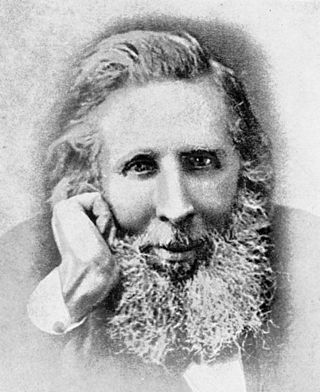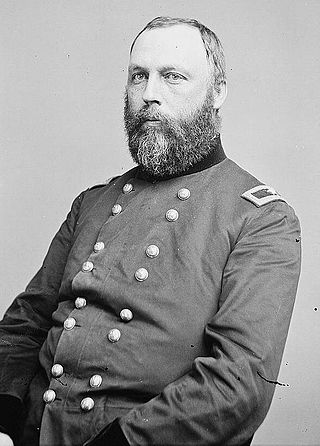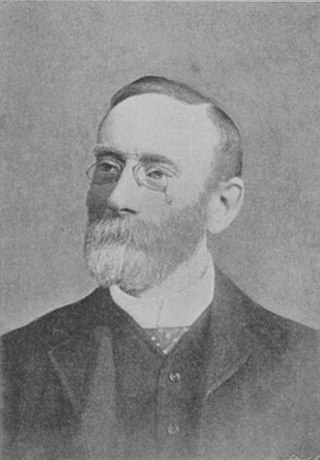
Abraham "Bram" Stoker was an Irish author who is best known for writing the 1897 Gothic horror novel Dracula. During his lifetime, he was better known as the personal assistant of actor Sir Henry Irving and business manager of the West End's Lyceum Theatre, which Irving owned.

Sir William Robert Wills Wilde FRCSI was an Irish oto-ophthalmologic surgeon and the author of significant works on medicine, archaeology and folklore, particularly concerning his native Ireland. He was the father of Oscar Wilde.

Jane Francesca Agnes, Lady Wilde was an Irish poet under the pen name Speranza and supporter of the nationalist movement. Lady Wilde had a special interest in Irish folktales, which she helped to gather and was the mother of Oscar Wilde and Willie Wilde.
The Ethnological Society of London (ESL) was a learned society founded in 1843 as an offshoot of the Aborigines' Protection Society (APS). The meaning of ethnology as a discipline was not then fixed: approaches and attitudes to it changed over its lifetime, with the rise of a more scientific approach to human diversity. Over three decades the ESL had a chequered existence, with periods of low activity and a major schism contributing to a patchy continuity of its meetings and publications. It provided a forum for discussion of what would now be classed as pioneering scientific anthropology from the changing perspectives of the period, though also with wider geographical, archaeological and linguistic interests.
A panacea is any supposed remedy that is claimed to cure all diseases and prolong life indefinitely. Named after the Greek goddess of universal remedy Panacea, it was in the past sought by alchemists in connection with the elixir of life and the philosopher's stone, a mythical substance that would enable the transmutation of common metals into gold. Through the 18th and 19th centuries, many "patent medicines" were claimed to be panaceas, and they became very big business. The term "panacea" is used in a negative way to describe the overuse of any one solution to solve many different problems, especially in medicine. The word has acquired connotations of snake oil and quackery.

John Francis Campbell, also known as Young John of Islay was a Scottish author and scholar who specialised in Celtic studies, considered an authority on the subject.

Who's Who is a reference work. It has been published annually in the form of a hardback book since 1849, and has been published online since 1999. It has also been published on CD-ROM. It lists, and gives information on, people from around the world who influence British life. Entries include notable figures from government, politics, academia, business, sport and the arts. Who's Who 2023 is the 175th edition and includes more than 33,000 people.

William Alexander Hammond was an American military physician and neurologist. During the American Civil War he was the eleventh Surgeon General of the United States Army (1862–1864) and the founder of the Army Medical Museum.

Arthur Jacob (1790–1874) was an Irish ophthalmologist. He is known for founding several hospitals, a medical school, and a medical journal. He contributed to science and academia through his 41-year term as Professor of Anatomy at the Royal College of Surgeons in Ireland (RCSI) and as the first Irish ocular pathologist. He was elected President of RCSI in 1837 and 1864.

Richard Robert Madden was an Irish doctor, writer, abolitionist and historian of the United Irishmen. Madden took an active role in trying to impose anti-slavery rules in Jamaica on behalf of the British government.

The Illustrated Sporting and Dramatic News was a British weekly magazine founded in 1874 and published in London. In 1945 it changed its name to the Sport and Country, and in 1957 to the Farm and Country, before closing in 1970.
John Benignus Lyons, better known as J. B. Lyons and widely known as Jack Lyons, was an Irish physician, medical historian, writer, and professor of medical history. He was described as "one of the foremost Irish medical writers of the twentieth century".

The Irish Journal of Medical Science is a quarterly peer-reviewed medical journal that was established in 1832 by Robert Kane as the Dublin Journal of Medical & Chemical Science. Besides Kane, it had distinguished editors like Robert James Graves and William Wilde. It is the official organ of the Royal Academy of Medicine in Ireland and published by Springer Science+Business Media.

Sir Philip Crampton, 1st Baronet, FRSMRCSI was an eminent Irish surgeon and anatomist. He was President of the Royal College of Surgeons in Ireland (RCSI) in 1811, 1820, 1844 and 1855.

James Little was an Irish medical practitioner. After spending an early part of his career as a ship's surgeon, surviving a shipwreck, he became chief physician at the Adelaide Hospital in Dublin and Regius Professor of Physic at Trinity College Dublin.

Forbes Benignus Winslow DCL, FRCP Edin., MRCP, MRCS, MD, was a British psychiatrist, author and an authority on mental illness during the Victorian era.
Park Street School of Medicine was a private medical school in Dublin, Ireland. It was founded on Park Street, Dublin, in 1824 by a group of renowned physicians, including Robert James Graves and Arthur Jacob. In 1849, Professor Hugh Carlisle purchased for £500 the School's anatomy specimens which he relocated to Queen's College, Belfast.

Herbert Vivian was an English journalist, author and newspaper owner, who befriended Lord Randolph Churchill, Charles Russell, Leopold Maxse and others in the 1880s. He campaigned for Irish Home Rule and was private secretary to Wilfrid Blunt, poet and writer, who stood in the 1888 Deptford by-election. Vivian's writings caused a rift between Oscar Wilde and James NcNeil Whistler. In the 1890s, Vivian was a leader of the Neo-Jacobite Revival, a monarchist movement keen to restore a Stuart to the British throne and replace the parliamentary system. Before the First World War he was friends with Winston Churchill and was the first journalist to interview him. Vivian lost as Liberal candidate for Deptford in 1906. As an extreme monarchist throughout his life, he became in the 1920s a supporter of fascism. His several books included the novel The Green Bay Tree with William Henry Wilkins. He was a noted Serbophile; his writings on the Balkans remain influential.

Arthur Wynne Foot was an Irish doctor, professor of medicine, and an entomologist.
Irish Gothic literature developed in the eighteenth and nineteenth centuries. Most of the writers were Anglo-Irish. The period from 1691 to 1800 was marked by the dominance of the Protestant Ascendancy, Anglo-Irish families of the Church of Ireland who controlled most of the land. The Irish Parliament, which was almost exclusively Protestant in composition, passed the Penal Laws, effectively disenfranchising the Catholic majority both politically and economically. This began to change with the Acts of Union 1800 and the concomitant abolition of the Irish Parliament. Following a vigorous campaign led by Irish lawyer Daniel O'Connell, Westminster passed the Roman Catholic Relief Act 1829 removing most of the disabilities imposed upon Catholics.















